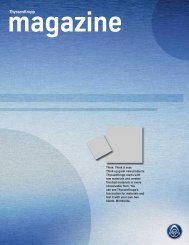Engineering
Engineering
Engineering
Create successful ePaper yourself
Turn your PDF publications into a flip-book with our unique Google optimized e-Paper software.
3.6 Consolidated financial statements Notes to the consolidated financial statements<br />
3.6 Consolidated financial statements Notes to the consolidated financial statements<br />
On initial classification as held for sale, non-current assets are<br />
recognized at the lower of the carrying amount and fair value less costs<br />
to sell and depreciation and amortization ceases. A disposal group is<br />
initially measured in line with the respective IFRS standards to<br />
determine the carrying amount of the disposal group which is then<br />
compared to the fair value less costs to sell of the group in order to<br />
recognize the group at the lower of both amounts. Impairment losses<br />
on initial classification as held for sale are included in profit or loss, as<br />
are gains and losses on subsequent remeasurement, but not in excess<br />
of the cumulative impairment loss.<br />
Financial statement classification<br />
Certain line items in the consolidated statement of income and on the<br />
consolidated balance sheet have been combined. These items are<br />
disclosed separately in the Notes to the consolidated financial<br />
statements. Certain reclassifications have been made to the prior year<br />
presentation to conform to that of the current year.<br />
In general the Group classifies assets and liabilities as current when<br />
they are expected to be realized or settled within twelve months after<br />
the balance sheet date. Group companies that have operating cycles<br />
longer than twelve months classify assets and liabilities as current if<br />
they are expected to be realized within the company’s normal<br />
operating cycle.<br />
Use of estimates<br />
The preparation of the Group consolidated financial statements<br />
requires Management to make judgements, estimates and<br />
assumptions that affect the application of policies and reported<br />
amounts of assets and liabilities, income and expenses. Actual results<br />
may differ from these estimates.<br />
The estimates and underlying assumptions are reviewed on an<br />
ongoing basis. Revisions to accounting estimates are recognized in the<br />
period in which the estimate is revised if the revision affects only that<br />
period, or in the period of the revision and future periods if the revision<br />
affects both current and future periods.<br />
Accounting estimates and judgements made by Management in the<br />
application of IFRS that have a significant effect on the consolidated<br />
financial statements are presented in Note 25.<br />
Recently adopted accounting standards<br />
In fiscal year 2010/2011, ThyssenKrupp adopted the following<br />
standards, interpretations and amendments to already existing<br />
standards:<br />
In October 2009 the IASB issued an amendment to IAS 32 “Financial<br />
Instruments: Presentation”. The amendment addresses the accounting<br />
for rights, options and warrants issues that are denominated in a<br />
currency other than the functional currency of the issuer. The<br />
amendment is compulsory for fiscal years beginning on or after<br />
February 01, 2010. The adoption of the amended standard did not<br />
have a material impact on the Group’s consolidated financial<br />
statements.<br />
In June 2009 the IASB issued an amendment to IFRS 2 “Share-based<br />
Payment – Group Cash-settled Share-based Payment Transactions”<br />
that clarify the accounting for Group cash-settled share-based payment<br />
transactions in the individual financial statements of the subsidiary.<br />
Furthermore the amendment to IFRS 2 incorporates guidance<br />
previously included in IFRIC 8 “Scope of IFRS 2” and IFRIC 11 “IFRS 2<br />
– Group and Treasury Share Transactions”. The application of the<br />
amended standard is compulsory for fiscal years beginning on or after<br />
January 01, 2010. The adoption of the amended standard did not<br />
have a material impact on the Group’s consolidated financial<br />
statements.<br />
In November 2008 the IFRIC issued IFRIC 17 “Distributions of Noncash<br />
Assets to Owners”. The interpretation addresses the accounting<br />
of distributions of assets other than cash to its owners. IFRIC 17 is<br />
compulsory for fiscal years beginning after October 31, 2009. The<br />
adoption of the interpretation did not have a material impact on the<br />
Group’s consolidated financial statements.<br />
In January 2009 the IFRIC issued IFRIC 18 “Transfers of Assets from<br />
Customers”. IFRIC 18 clarifies the requirements of IFRSs for<br />
agreements in which an entity receives from a customer an item of<br />
property, plant and equipment that the entity must then either use to<br />
connect the customer to a network or to provide the customer with<br />
ongoing access to a supply of goods or services. The interpretation is<br />
compulsory for fiscal years beginning after October 31, 2009. The<br />
adoption of the interpretation did not have a material impact on the<br />
Group’s consolidated financial statements.<br />
144

















